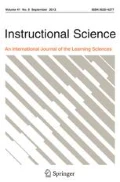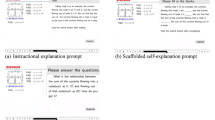Abstract
Cognitive science principles should have implications for the design of effective learning environments. The self-explanation principle was chosen for the current work because it has developed significantly over the last 20 years. Early formulations hypothesized that self-explanation facilitated inference generation to supply missing information about a concept or target skill, whereas later work hypothesized that self-explanation facilitated mental-model revision (Chi, Handbook of research on conceptual change, 2000). To better understand the complex relationship between prior knowledge, cognitive processing, and changes to a learner’s representation, two classes of self-explanation prompts (gap-filling and mental-model revision) were tested in the domain of physics problem solving. Prompts designed to focus the learner on gap-filling led to greater learning and a reduction in the amount of tutoring assistance required to solve physics problems. The results are interpreted as support for the instructional fit hypothesis—the idea that the efficacy of instruction is contingent on the match between the cognitive processing that the instruction elicits, how those processes modify the underlying knowledge representations for the task, and the utility of those representations for the task or problem.









Similar content being viewed by others
References
Aleven, V. A. W. M. M., & Koedinger, K. R. (2002). An effective metacognitive strategy: Learning by doing and explaining with a computer-based Cognitive Tutor. Cognitive Science, 26, 147–179.
Anderson, J. R. (1993). Rules of the mind. Hillsdale, NJ: Lawrence Erlbaum Associates.
Anderson, J. R., Corbett, A. T., Koedinger, K. R., & Pelletier, R. (1995). Cognitive tutors: Lessons learned. The Journal of the Learning Sciences, 4(2), 167–207.
Anderson, J. R., & Lebiere, C. (1998). The atomic components of thought. Mahwah, NJ: Lawrence Erlbaum Associates.
Baker, R. S., Corbett, A. T., Koedinger, K. R., & Wagner, A. Z. (2004). Off-task behavior in the Cognitive Tutor classroom: When students “game the system”. Proceedings of ACM CHI 2004: Computer-Human Interaction, 383–390.
Berthold, K., Eysink, T. H., & Renkl, A. (2009). Assisting self-explanation prompts are more effective than open prompts when learning with multiple representations. Instructional Science, 37, 345–363.
Catrambone, R. (1998). The subgoal learning model: Creating better examples so that students can solve novel problems. Journal of Experimental Psychology: General, 127(4), 355–376.
Chapin, S., O’Connor, C., & Anderson, N. (2003). Classroom discussions: Using math talk to help students learn, grades 1–6. Sausalito, CA: Math Solutions Publications.
Chi, M. T. H. (2000). Self-explaining expository texts: The dual processes of generating inferences and repairing mental models. In R. Glaser (Ed.), Advances in instructional psychology (pp. 161–238). Mahwah, NJ: Lawrence Erlbaum Associates, Inc.
Chi, M. T. H. (2008). Three kinds of conceptual change: Belief revision, mental model transformation, and ontological shift. In S. Vosniadou (Ed.), Handbook of research on conceptual change (pp. 61–82). New York, NY: Routledge.
Chi, M. T. H., & Bassok, M. (1989). Learning from examples via self-explanations. In L. B. Resnick (Ed.), Knowing, learning, and instruction: Essays in honor of Robert Glaser (pp. 251–282). Hillsdale, NJ: Lawrence Erlbaum Associates, Inc.
Chi, M. T. H., DeLeeuw, N., Chiu, M.-H., & Lavancher, C. (1994). Eliciting self-explanations improves understanding. Cognitive Science, 18, 439–477.
Cohen, J. (1988). Statistical power analysis of the behavioral sciences (2nd ed.). New York: Academic Press.
Conati, C., & VanLehn, K. (2000). Toward computer-based support of meta-cognitive skills: A computational framework to coach self-explanation. International Journal of Artificial Intelligence in Education, 11, 398–415.
Hausmann, R. G. M., & Chi, M. T. H. (2002). Can a computer interface support self-explaining? Cognitive Technology, 7(1), 4–14.
Hausmann, R. G. M., & VanLehn, K. (2007). Explaining self-explaining: A contrast between content and generation. In R. Luckin, K. R. Koedinger, & J. Greer (Eds.), Artificial intelligence in education: Building technology rich learning contexts that work (Vol. 158, pp. 417–424). Amsterdam: IOS Press.
Keppel, G. (1991). Design and analysis: A researcher’s guide. Upper Saddle River, NJ: Prentice Hall.
Koedinger, K. R., Anderson, J. R., Hadley, W. H., & Mark, M. A. (1997). Intelligent tutoring goes to school in the big city. International Journal of Artificial Intelligence in Education, 8, 30–43.
Maloney, D. P., O’Kuma, T. L., Hieggelke, C. J., & Van Heuvelen, A. (2001). Surveying students’ conceptual knowledge of electricity and magnetism. American Journal of Physics, 69(7), S12–S23.
Marshall, S. P. (1995). Schemas in problem solving. Cambridge, UK: Cambridge University Press.
McNamara, D. S. (2004). SERT: Self-explanation reading training. Discourse Processes, 38(1), 1–30.
Nokes, T. J., Schunn, C. D., & Chi, M. T. H. (2010). Problem solving and human expertise. In P. Peterson, E. Baker, & B. McGraw (Eds.), International encyclopedia of education (Vol. 5, pp. 265–272). Oxford: Elsevier.
Olejnik, S., & Algina, J. (2000). Measures for effect size for comparative studies: Applications, interpretations, and limitations. Contemporary Educational Psychology, 25, 241–286.
Pashler, H., Bain, P., Bottge, B., Graesser, A., Koedinger, K., McDaniel, M., & Metcalfe, J. (2007). Organizing Instruction and Study to Improve Student Learning (NCER 2007–2004). Washington, DC: National Center for Education Research, Institute of Education Sciences, U.S. Department of Education.
Renkl, A. (2002). Learning from worked-out examples: Instructional explanations supplement self-explanations. Learning & Instruction, 12, 529–556.
Rittle-Johnson, B. (2006). Promoting transfer: Effects of self-explanation and direct instruction. Child Development, 77, 1–15.
Ross, B. H. (1984). Remindings and their effects in learning a cognitive skill. Cognitive Psychology, 16, 371–416.
Ross, B. H., & Kilbane, M. C. (1997). Effects of principle explanation and superficial similarity on analogical mapping in problem solving. Journal of Experimental Psychology. Learning, Memory, and Cognition, 23(2), 427–440.
Singley, M. K., & Anderson, J. R. (1989). The transfer of cognitive skill. Cambridge, MA: Harvard University Press.
VanLehn, K. (1998). Analogy events: How examples are used during problem solving. Cognitive Science, 22(3), 347–388.
VanLehn, K., Lynch, C., Schultz, K., Shapiro, J. A., Shelby, R., Taylor, L., et al. (2005). The Andes physics tutoring system: Lessons learned. International Journal of Artificial Intelligence and Education, 15(3), 147–204.
Acknowledgments
This work was supported by the National Science Foundation, Grant Number SBE-0354420 to the Pittsburgh Science of Learning Center (http://www.learnlab.org). No endorsement should be inferred. Portions of the results were presented at the Cognitive Science Society’s 31st Annual Conference. We would like to thank the members of the Cognitive Science Learning Laboratory and several anonymous reviewers for their many helpful comments and suggestions.
Author information
Authors and Affiliations
Corresponding author
Appendix
Appendix
Rights and permissions
About this article
Cite this article
Nokes, T.J., Hausmann, R.G.M., VanLehn, K. et al. Testing the instructional fit hypothesis: the case of self-explanation prompts. Instr Sci 39, 645–666 (2011). https://doi.org/10.1007/s11251-010-9151-4
Received:
Accepted:
Published:
Issue Date:
DOI: https://doi.org/10.1007/s11251-010-9151-4



